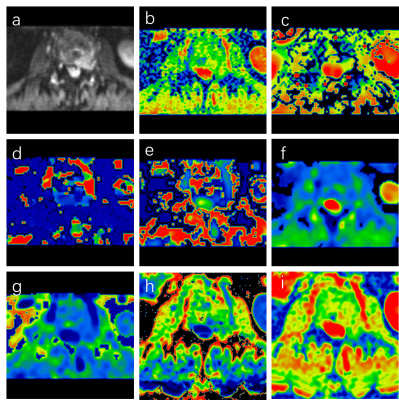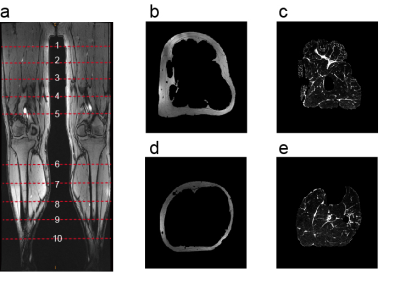Online Gather.town Pitches
MSK II
Joint Annual Meeting ISMRM-ESMRMB & ISMRT 31st Annual Meeting • 07-12 May 2022 • London, UK

| Booth # | ||||
|---|---|---|---|---|
3107 |
1 | Association of Thigh Muscle Fat with Isometric Strength Measurements in Patients with T2DM Using Chemical Shift Encoding-Based Water-Fat MRI Video Not Available
Hongli Zhu1, Yilong Huang1, Lisha Nie2, Hanxue Cun1, Tianfu Qi1, and Bo He1
1Department of Medical Imaging, First Affiliated Hospital of Kunming Medical University, Kunming, China, 2GE Healthcare, MR Research China, Beijing, China
Iterative decomposition of water and fat with echo asymmetry and least-squares estimation quantitation sequence (IDEAL-IQ) is a chemical shift encoding-based water-fat MRI technique which allows noninvasive fat quantification. In this study, we investigated the correlation between thigh muscle fat fraction (FF) and isokinetic strength measurements in middle-aged and elderly obese participants with T2DM scanned at 3.0T MR. Intramuscular FF was shown to be a significant predictor of peak torque (PT) and total work (TW) in the thigh muscle. Therefore, intramuscular FF might provide reliable imaging markers for the prevention and monitoring of thigh muscle dysfunction in participants with T2DM.
|
||
3108 |
2 | Exercise-induced muscle hyperemia as quantified by a BOLD modelling approach
Yujie Wang1,2, Christopher J. Hanrahan3, and Jeff L. Zhang1
1Vascular and Physiologic Imaging Research (VPIR) Lab, School of Biomedical Engineering, ShanghaiTech University, Shanghai, China, 2School of Life Science and Technology, ShanghaiTech University, Shanghai, China, 3Department of Radiology and Imaging Sciences, University of Utah, Salt Lake City, UT, United States
Muscle hyperemia after exercise is a physiologic phenomenon that could reflect muscle function and performance. For a group of human subjects, we performed dynamic BOLD scan of calf muscles immediately after in-scanner plantar flexion. To analyze the dynamic data, a kinetic model of deoxy-hemoglobin (dHb) was proposed, with exponentially decayed perfusion as determinant. A hyperemia index (HI) was defined based on the estimated perfusion parameters, and was compared to muscle perfusion measured by DCE scans. In conclusion, we proposed a quantitative model for analyzing post-exercise muscle BOLD data, and the new parameter “hyperemia index”.
|
||
3109 |
3 | Preliminary study of various models of DWI and diffusion kurtosis imaging on differential diagnosis of spinal metastase and chordoma
Jiahui Zhang1,2, Qizheng Wang2, and Ning Lang2
1Department of Radiology, Peking Union Medical College Hospital, Beijing, China, 2Peking University Third Hospital, Beijing, China Metastases and chordoma are both malignant tumors. When the manifestations are not typical, the two are prone to misdiagnosis. DWI using a biexponential model measured ADC, D, D*, and f. DWI using a stretched-exponential model obtained DDC, and α. DKI derived MD and MK. The monoexponential, biexponential, and stretched-exponential models of DWI and DKI have differential diagnostic value for spinal metastases and chordoma. Among the single parameter values, the D value has the highest AUC. Combining the values of three parameters (D, f, and α) can significantly improve the diagnostic efficiency of identifying spinal metastases and chordoma. |
||
3110 |
4 | Development and validation of an MRI-based radiomics nomogram for distinguishing multiple myeloma from bone metastasis of breast cancer Video Permission Withheld
Miyuki Takasu1, Konagi Takeda1, Saki Kawai1, Nobuko Tanitame1, Akihisa Tamura1, Makoto Iida1, Yuji Akiyama2, and Kazuo Awai2
1Diagnostic Radiology, Hiroshima City Hiroshima Citizens Hospital, Hiroshima, Japan, 2Diagnostic Radiology, Hiroshima University Hospital, Hiroshima, Japan
We established and validated the feasibility of an MRI-based radiomics nomogram to differentiate between multiple myeloma (MM) and bone metastasis of breast cancer (BC). Regions of interest were drawn for the largest bone lesion per patient on T1- and T2-weighted images of patients with MM (n = 85) and BC (n = 70) from two institutions. The machine learning model with logistic regression resulted in the best performance for differentiating MM from BC with both sequences in the test cases. Our proposed clinical radiomics analysis shows promise in differentiating MM from bone metastasis of BC.
|
||
3111 |
5 | Intravoxel incoherent motion imaging of masticatory muscles in patients with head and neck cancer
Chia-Wei Lin1, Kai-Lun Cheng2, Hsueh-Ju Lu3, Ying-Hsiang Chou1,4, Yeu-Sheng Tyan1,2, and Ping-Huei Tsai1,2
1Department of Medical Imaging and Radiological Sciences, Chung Shan Medical University, Taichung, Taiwan, 2Department of Medical Imaging, Chung Shan Medical University Hospital, Taichung, Taiwan, 3Division of Medical Oncology, Department of Internal Medicine, Chung Shan Medical University Hospital, Taichung, Taiwan, 4Department of Radiation Oncology, Chung Shan Medical University Hospital, Taichung, Taiwan
Head and Neck Cancer (HNC) is one of the most common cancers worldwide. Although skeletal muscle depletion or muscle dysfunction is associated with cancer progression, changes in masticatory muscle diffusion and perfusion in HNC are still unclear. This study aims to assess the masticatory muscle perfusion and diffusion in HNC using intravoxel incoherent motion (IVIM) imaging. Our preliminary result indicated the normalized D* values in masticatory muscles were significantly lower in HNC patients than that in controls, suggesting the possibility of reduced masticatory muscle perfusion in HNC.
|
||
3112 |
6 | Lower-limb fat: how it is distributed spatially and its potential in approximating whole-body fat content Video Permission Withheld
Xin Mu1, Zhenfeng Lv2, Meng Tian3, and Jeff L Zhang1
1Vascular and Physiologic Imaging Research (VPIR) Lab, School of Biomedical Engineering, ShanghaiTech University, Shanghai, China, 2School of Biomedical Engineering, ShanghaiTech University, Shanghai, China, 3School of Biomedical Engineering, Shanghai Jiao Tong University, Shanghai, China Fat content in lower limb is of highly clinical interest as it reflects physical activity. In this study, we quantified lower-limb fat content in a comprehensive way using a Dixon method. We found that fat content in lower limb generally decreased from pelvis to ankle. Of particular note, fat content in thigh was significantly higher than that in calf, and can potentially differentiate subjects with different body-mass index (BMI). It is also encouraging that fat content for a single cross-section at mid-thigh (30 sec scan time) approximated whole-limb fat content well, as it makes whole-body quantification in clinical setting feasible. |
||
The International Society for Magnetic Resonance in Medicine is accredited by the Accreditation Council for Continuing Medical Education to provide continuing medical education for physicians.